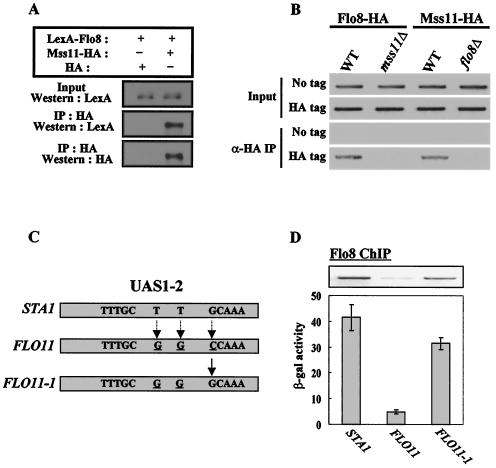FIG. 2.
Flo8 and Mss11 bind to the inverted repeat sequence in UAS1-2. (A) Physical interaction between Flo8 and Mss11. Cells carrying plasmids expressing either LexA-Flo8 and Mss11-HA or LexA-Flo8 and HA were grown in selective medium containing 2% glucose. Protein extracts (500 μg) were immunoprecipitated (IP) with anti-HA antibody. Input extracts (50 μg) and the precipitates were separated by SDS-8% PAGE and analyzed by blotting with LexA antibody. The membrane was stripped and reprobed with anti-HA antibody. +, present; −, absent. (B) Flo8 and Mss11 bind cooperatively to UAS1-2. FLO8-HA wild-type (WT), FLO8-HA mss11Δ, MSS11-HA wild-type, MSS11-HA flo8Δ, or untagged strains bearing pLG-UAS1-2 were grown in synthetic medium containing 2% glycerol-ethanol to mid-log phase and treated with formaldehyde to cross-link DNA and proteins. Anti-HA (α-HA) chromatin immunoprecipitation was performed with 1 mg of total extracts, and the UAS1-2 region was PCR amplified with the purified DNA to determine the binding of Flo8 and Mss11 to UAS1-2 in pLG-UAS1-2. (C) Comparison of nucleotide sequences in UAS1-2 of the STA1 and the corresponding region of the FLO11 promoter. STA1, the inverted repeat sequence within UAS1-2 of the STA1 promoter is indicated. FLO11, the GCAAA sequence is altered to CCAAA in the FLO11 promoter. Three different bases of the UAS1-2 sequence between the STA1 and FLO11 promoters are underlined. FLO11-1, the CCAAA sequence in the FLO11 promoter was replaced with GCAAA by site-directed mutagenesis. (D) Effect of the inverted repeat sequence on Flo8 binding and lacZ expression. Transformants carrying plasmids pLG-UAS1-2[STA1], pLG-UAS1-2[FLO11], or pLG-UAS1-2[FLO11-1] were subjected to β-galactosidase (β-gal) assay under derepressing conditions (2% glycerol-ethanol). The results of a ChIP experiment with the FLO8-HA wild type, which contains each plasmid, are presented in the upper panel.

